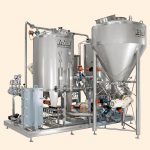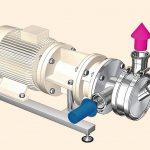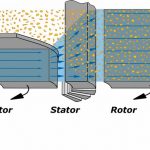Only after being mixed into liquids do powders fulfil their real and final purpose – as colour pigments, thickeners, flavours, matting agents, fillers, reinforcing fibres, catalysts, et cetera. The quality of the final product depends essentially on how well or how badly the powder is decomposed, in other words how effectively every single particle has been wetted and dispersed. If your yoghurt tastes better and your paint is applied more evenly, your photo prints are sharper or your suncream protects your skin much better, then a powerful dispersing machine such as the Conti-TDS was very probably involved.
Mixing and dispersing machine uses vacuum expansion method
The answer is in the air
Only after being mixed into liquids do powders fulfil their real and final purpose – as colour pigments, thickeners, flavours, matting agents, fillers, reinforcing fibres, catalysts, et cetera. The quality of the final product depends essentially on how well or how badly the powder is decomposed, in other words how effectively every single particle has been wetted and dispersed. If your yoghurt tastes better and your paint is applied more evenly, your photo prints are sharper or your suncream protects your skin much better, then a powerful dispersing machine such as the Conti-TDS was very probably involved.
Whenever paint manufacturing costs are reduced to one tenth, a resin takes only seconds to dissolve rather than hours, a million-dollar paper coating machine runs at twice the speed or the batteries of an aging tank can be dispensed with in an ice cream production process, the reason is always the same: a well-engineered technology for powder dispersion. This technology separates each particle in the powder using a specific vacuum expansion method. The particles are wetted completely and instantaneously, and dispersed on first contact with the liquid. They are also distributed homogeneously at the same time.
With traditional methods of powder addition, either on top of the liquid surface or possibly below it in vacuum vessels, such as common in-line blenders or injectors, the powder always comes into contact with the liquid as a bulk. The powder particles touch each other. The liquid only wets the compact, and often agglomerated, product from the outside. Local, over-concentrated clusters and wet lumps are created.
All these agglomerates have to be destroyed, resulting in a long mixing time and extensive additional dispersing. This in turn has many negative side-effects and is anything but helpful in most cases:
- With yoghurt or desserts the texture is partially destroyed and more proteins and stabilisers are required
- With shampoos and gels the viscosity is reduced and more thickener is needed
- With paints and coatings the binder is stressed and the quality is lower
- With polymer dispersions unacceptable heating takes place, so that efficient external cooling is a must
- Additional dispersing requires time, energy and extra tank capacity
- To avoid agglomerates during wetting and create sufficient space between the particles to allow unhindered penetration of the liquid, these particles have to be separated. Enough distance has to be ensured between each one. Yet how can this best be achieved? Vacuum expansion of the air in a streaming powder is the answer. No additional air is needed. Any powder contains air – quite a lot, in fact. The air content can be easily calculated from the ratio of bulk density to true density of the solids. Even heavy powders such as titanium dioxide still contain 75 % air. Light powders contain much more.
Always in motion
Air expands under vacuum to a multiple of its initial volume. This is exactly what happens when powder is inducted by vacuum. In the streaming powder the distance between particles increases in line with the vacuum due to the expansion of the air. Even compact and dense powders become remarkably fluidised without any additional fluidising air.
It is important that the powder keeps moving under vacuum. It is conveyed at high speed in the inducted powder stream all the way into the dispersing zone and finally into the dispersed liquid. This expansion effect would not work in a vacuum vessel or a rotary feeder, where the powder would settle or retain its bulk density even under vacuum.
Principle of the dispersing unit
The Ystral Conti-TDS uses the volume expansion effect to induct and disperse powders into liquids. Its particular feature is a specially designed wetting chamber which creates a maximum vacuum in its dispersing zone, allowing the powder to be directly inducted into the liquid phase.
The powder and the liquid reach this zone by completely separate routes. They cannot mix in an uncontrolled manner and do not build up agglomerates – only in the wetting zone and under maximum vacuum they are able to come into contact with each other. Since the maximum vacuum occurs at this point, it is here where the distance between the particles is greatest. The particles are separated as they pass the rotor-stator system and completely wetted by the liquid due to the intensive dispersing at maximum turbulence.
Once the powder has been completely dispersed into the liquid, another question arises: what happens to the air that was present in the powder? It cannot simply disappear. The answer is very simple: because of the centrifugal effect of the high-speed rotor, the air is separated from the significantly heavier liquid dispersion and coagulates to form large air bubbles, which deaerate easily in the downstream process vessel.
With the Conti-TDS, the powder is not added to a tank on the surface of a liquid and there is therefore no dust above this surface inside the tank. Dust above the liquid level always results in powder crusts and contamination on the tank wall, lid, mixer shaft and all sensors or other internals. Such contamination is difficult to clean and very often crumbles away, polluting the product. Owing to the external in-line addition principle of the Conti-TDS, this problem is now a thing of the past. Product quality, cleanliness and reliability are significantly improved.
The Conti-TDS can be used very flexibly. The machine inducts the powder directly from a paper bag, sack tip or big bag station, hopper or container. It can be connected to more than one processing vessel or used at several different sites as a mobile version on casters. It also integrates very easily into existing processing systems.
Hall 9, Booth E36
www.cpp-net.com search: cpp0316ystral
By separate routes
Facts & Figures
Facts & Figures
By separate routes
The advantages of the Conti-TDS derive from its functional principle:
- Powders are dispersed in a dispersing zone at maximum turbulence and a high energy density
- To avoid agglomerates, the powder and liquid are guided into the wetting and dispersing zone by completely separate routes
- The surface of the liquid is expanded millions of times at the moment of wetting
- Wetting is carried out under vacuum. This causes the powder to expand and increases the distance between the particles
- Dispersing takes place simultaneously with powder wetting and not afterwards
- Air is separated by centrifugal forces and escapes easily
- Powders have different properties: they may be hydrophilic or hydrophobic and they may swell, stick, thicken, be abrasive or shear sensitive or even react with the liquid. The Conti-TDS can be easily adapted to all specific conditions and requirements and optionally equipped with several powder inlets or exchangeable tools
Dr.-Ing. Hans-Joachim Jacob
Dr.-Ing. Hans-Joachim Jacob
Process- and Application Engineering,
Ystral
Share:









